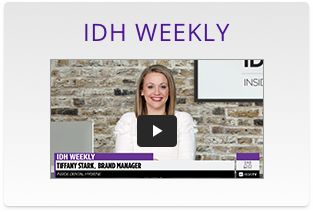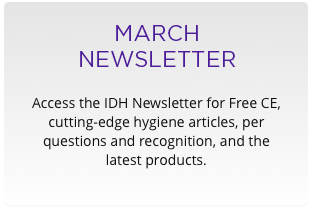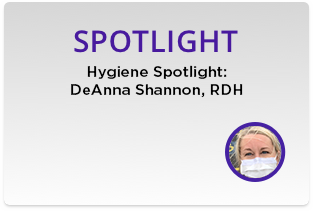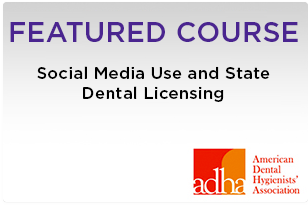IDH Questions and Answers
March Q & A: Scheduling – Striking a Balance with Patient Care & Office Standards on Time
Ask IDH –March 9, 2020
Melissa M. RDH, Jacksonville, FL
I am a recent graduate and I am having difficulty staying on time with my patients. I have 45 minutes with each patient, and I tend to run 10-15 minutes behind schedule every day. Although I want to provide the same level of care that I did when I was in school, I am concerned that I may lose my job. My office manager has brought this issue up with me on a few occasions, so I am becoming more nervous that this will affect my employment. I really enjoy my patients and I want the best for them. Can you offer me some advice about being more efficient with my appointments?
IDH
Early in your career, it’s not uncommon to become thrown off schedule, but you will become more efficient with experience. First, you might want to ask more senior hygienists in the office for tips on how they stay on time. Other tips that might help:
1. Be prepared for your appointments: If you know that your patient will need radiographs, have everything in the room ready to go. Leaving the room to get different items can cost you a lot of time. Taking time in the beginning of the day or at the end of the previous day to read your patients’ records and determine if they need radiographs, antibiotic prophylaxis, local anesthesia, fluoride varnish, or any other adjunct procedure can help you to be prepared for each appointment.
2. Be efficient with your infection control: There are many excellent disinfectants that have a 1-minute contact time. Regardless of the disinfectant, it is important to employ the technique of spray-wipe-spray for spray disinfectants or wipe-discard-wipe for disinfectant wipes. If you use a more efficient disinfectant, you can prepare your operatory more quickly.
3. Break down the appointment into how much time you need for each aspect: Determine how much time you need for radiographs/clinical assessments and for the prophylaxis. With a 45-minute schedule, you could ask for an exam with 10-15 minutes remaining in the appointment to allow the doctor enough time to examine the patient, giving you more time to dismiss the patient and prepare the operatory for the next person.
In the meantime, schedule a meeting with your office manager to discuss the steps you will take to improve efficiency in the practice. Hopefully this will take the pressure off as you become increasingly efficient.
December Q & A: Choosing Continuing Education Courses
Ask IDH – December 9, 2019
Ashley F., RDH, Rockville, MD
How should I approach choosing continuing education courses? There are so many available and I want my techniques and product recommendations to stay up to date. I would also like to meet other dental hygienists. When I was in school, I thrived on the camaraderie I had with my classmates and I miss that.
IDH
Continuing education opportunities for hygienists are expanding in all areas. From accessible online courses to live programs at meetings, CE is available everywhere you look. When it comes to choosing what topics to take (and where), there are a lot of professional and personal factors to consider.
First, what are your state requirements? Consult your state dental board for the latest information on continuing education requirements, and to confirm what specific courses are accepted. For example, not all states consider webinars as live CE credits. In addition, as you explore different opportunities, you will want to ascertain who the provider is (company, organization, school) and its accreditation status, and to check reviews from other students or attendees.
What are your professional goals? Are you planning to become certified in certain treatment techniques? Do you want to pick up new skills or technology? Many different topics could impact your career and your value as an employee. For example, is there an area in the practice that you could help expand or manage? Are you thinking of taking your career into an educational or administrative direction, rather than chairside?
How much time and money can you invest? There’s a wide range of fees associated with continuing education, and some require you to travel. While some courses can be taken online at your convenience, others are only offered at certain times and places. Does your employer offer time off or any options for reimbursement, and what are the parameters?
What is the best platform for you to fully comprehend that topic? Do you prefer live interaction where you can ask questions? Or do you like to watch a video multiple times to absorb the information? Do you prefer courses that are developed specifically for hygienists? Finding the right educational environment, led by a professional instructor, will go a long way toward increasing your confidence in your new knowledge.
Finally, start early. Thinking through your individual needs and planning ahead can help you gain the most benefit from your continuing education investment this year. Remember to check out the courses offered through our continuing education portal at idh/CDEWorld.com and those featured in our weekly video at aegisdentalnetwork.com/tv/idh-weekly.
November Q & A: Time Management for New Graduates
Ask IDH – November 11, 2019
Melissa M. RDH, Jacksonville, FL
I am a recent graduate and I am having difficulty staying on time with my patients. I have 45 minutes with each patient, and I tend to run 10-15 minutes behind every day. I want to provide the same level of care that I did when I was in school, but I am concerned that I may lose my job. My office manager has brought this issue up with me on a few occasions, so I am getting more nervous that this will affect my employment. I really enjoy my patients and I want the best for them. Can you offer me some advice about being more efficient with my appointments?
IDH
I remember early in my career when adding a full mouth series of radiographs to an appointment would throw off my entire morning or afternoon. I can assure you that you will become more efficient with experience. One thing that helped me was talking with the more senior hygienists in the office and asking them how they stay on time. Having said that, I can offer a few tips that might help:
1. Be prepared for you appointments: If you know that your patient will need radiographs, have everything in the room and ready to go. Leaving the room to get different items can cost you a lot of time. Taking time in the beginning of the day or at the end of the previous day to read your patients’ records and determine if they need radiographs, antibiotic prophylaxis, local anesthesia, fluoride varnish, or any other adjunct procedure can help you to be prepared for each appointment.
2. Be efficient with your infection control: There are many excellent disinfectants that have a 1-minute contact time. Regardless of the disinfectant, it is important to employ the technique of spray-wipe-spray for spray disinfectants or wipe-discard-wipe for disinfectant wipes. If you use a more efficient disinfectant, you can prepare your operatory over more quickly.
3. Break down the appointment into how much time you need for each aspect of your appointment. Determine how much time you need for radiographs/clinical assessments and for the prophylaxis. With a 45-minute schedule, I would strive to ask for an exam with 10-15 minutes remaining in the appointment to allow the doctor enough time to examine the patient, dismiss the patient and then prepare the operatory for the next
patient. Setting time goals throughout the appointment always helped me stay on time.
In the meantime, I might suggest scheduling a meeting with your office manager to discuss the steps you will take to improve efficiency in the practice. Hopefully this will take the pressure off of you as become increasingly efficient.
October Q & A: Handling Practice Acquisition
Ask IDH – October 7, 2019
Megan L., RDH, Denver, CO
The practice where I have been working for the last 14 years is going to be purchased in the very near future. I’ve been talking to many of my hygienist-friends and they said I should start looking for another office. I love my patients and the people I work with, and I would prefer to stay. But I am concerned that I may be fired as a result of the acquisition. A few of my friends said that new owners like to “clean house” and start over with new staff members. Do you have any advice about this?
IDH
Large changes in a practice can be quite stressful. While I have heard of instances of a new owner facilitating a 100% turnover of staff immediately following a practice acquisition, it is my understanding that it is more favorable to keep existing staff members, especially if the selling doctor isn’t planning to continue to practice after the acquisition. This creates good will with the patients. I might suggest scheduling a meeting with the new owner to express your interest in staying in the office and offer your support for a successful transition. Hopefully being upfront and honest with the new owner will set the tone for open communication and secure your place in the practice. Unfortunately, it is possible that you may be forced to search for a new opportunity or you may decide to leave if the new work situation does not meet your expectations. While that is entirely possible, I believe that communicating your desire to remain with the practice will help to improve the likelihood of a successful transition for you.
September Q & A: Giving Back as a Dental Hygienist
Ask IDH – September 9, 2019
Hailey R. RDH, Charleston, SC
I would like the opportunity to give back to my community and state by volunteering my services for one of the many organizations that provide dental care for those with limited access, but I am not sure where to start.
IDH
I want to commend you for taking an interest in helping those in need by volunteering your talents as a Dental Hygienist. Depending on your availability, there are a number of opportunities in local communities, statewide, nationally, and even internationally.
Nationally, the most well-known opportunity of course is the annual Give Kids a Smiles (GKAS) event the first Friday in February. In 2019, there were 1,633 locations with more than 30,000 volunteers. Another nationwide program is Special Smiles through the Special Olympics, which provides their athletes with free oral screenings and education on oral hygiene. Internationally, you can begin by researching active opportunities at Health Volunteers Oversea (HVO). The organization’s Dental Education Programs, sponsored by the ADA Foundation, train health workers in developing countries. In addition, many companies also sponsor oral health volunteer programs, such as Colgate Bright Smiles, Bright Futures, through which mobile vans travel to underserved communities.
With some research, you’re sure to find a program that works within your time commitments, interests, and skills. You might even organize one yourself.
August Q&A: Scheduling Management
Ask IDH – August 8, 2019
Sally T. RDH, Dayton, OH
I started working in a new practice, and I am experiencing a lot of difficulty staying on schedule. Before this, I had never had less than an hour for each patient, but now I am scheduled for 45-minute appointments for adults, regardless of their needs, and 30 minutes for children (under 18 years old). I respect the dentist and really like my co-workers, but this schedule is very stressful. I’m sure I will become more efficient over time, but I will never be able to take a full series of radiographs and provide a proper hygiene visit in 45 minutes. I want to schedule a meeting with my office manager and the dentist who owns the practice, but before then I was hoping that you could provide some tips so I can be prepared to present some solutions. Thanks in advance!
IDH
I worked in many offices when I was a dental hygienist and I can relate; some office settings are more challenging than others. It is wonderful that you work in an environment that you enjoy. That tells me that the staff is generally happy, so hopefully the administrative team is supportive in finding a solution to your dilemma. Since many offices run differently, yet successfully, I think that it would be useful to ask colleagues or reach out to specialists in practice management for specific advice for your practice, as the resolution may be multi-faceted. In my practice, the hygienist is in charge of her own appointments; if a patient requires more (or less) time, she schedules accordingly. Having said that, we have a daily production goal that can be broken down hourly. I would suggest asking for more autonomy for your schedule, while considering ways to create goals that demonstrate that your productivity would not be impacted by the changes you are proposing. Dental hygienists can be especially productive by offering adjunct procedures (depending on state regulations) and by promoting the necessary procedures that are recommended by the dentist.
I wish you luck in your meeting, and I hope that you are the catalyst for restructuring the dental hygiene department within this practice. It sounds to me that you are part of a great team, and I hope that you can create a schedule that is comfortable for you to treat your patients to the best of your abilities.
July Q&A: Dull Instruments
Ask IDH – July 8, 2019
Sharon R. RDH, Chandler, AZ
I would like your help to settle this discussion. I share my instruments with another dental hygienist, and I sharpen my instruments for every patient. She says that we only need to sharpen instruments when they get dull. Coincidentally, she says that she never sharpens our instruments because I keep them sharp enough for her. At a staff meeting, she has, in the past, accused me of over-sharpening our instruments. I’ve requested our own individual cassettes of instruments, but the office isn’t willing to invest in separate cassettes. Who’s right? Can I sharpen my instruments for each patient or should we sharpen once we decide that our instruments are dull?
IDH
Thank you for bringing up this important topic. While it is true that dull instruments can result in greater hand fatigue, burnishing calculus/incomplete removal of debris, longer appointments, and reduced productivity, they may not require sharpening prior to every patient visit. Some instruments are created with harder, tougher alloys that prevent dulling and don’t require sharpening as often as traditional stainless-steel scalers. My recommendation is 3-fold: first, investigate which instruments you have and identify the manufacturer’s recommendation for maintaining sharpness. Second, it may be useful to obtain sharpening sticks to test whether or not the instrument “bites” into the stick. (In general, if the instrument doesn’t bite into the stick, it needs to be sharpened.) Third, it seems that if a common understanding is reached with your co-worker, your instruments will be optimally maintained, and hopefully this will no longer cause disharmony in your office. Perhaps it might be enjoyable to take a course or watch a video together regarding the proper technique for sharpening your instruments. This may help to get you both on the same page with your techniques. I hope the two of you can come to a respectful understanding when it comes to maintaining your instruments.
June Q&A: Tips for Achieving Work-Life Balance
Ask IDH – June 10, 2019
Desiree, RHD, Atlanta, GA
I need your help! I really do love my job, but I am overwhelmed with everything. I see patients 5 days a week in a busy private practice. I have children and I try to be an active participant in their activities, including helping them with their homework every night. I also have a house, a husband, and a dog, and I feel that I don’t have any time for myself. I have been a dental hygienist for 13 years, and when I read about 4-wall syndrome or hygiene burnout, I feel like I might be reading about myself. What do dental hygienists do to combat this?
IDH
Thank you for reaching out to us! Unfortunately, many hygienists feel burned out and let those feelings fester until they no longer enjoy their career or finally leave clinical dental hygiene. It sounds to me that you could use some serious “me time.” I know this is easier said than done, but it is essential for all people to have a stress-relieving outlet, regardless of how busy life can be. One day I will share my story in its entirety, but one thing that has helped me is to find something that is enjoyable (and not related to dental hygiene) and make time for it. I knew that I needed to make time for personal wellness, but I had never been able to stick to a consistent activity or hobby. I decided that I would explore different activities and promised myself that I would make it a priority for 3 months. If I found something I enjoyed, I planned to prioritize it for an additional 3 months; otherwise I would look for something else to do. I started practicing hot yoga, and I absolutely love it! I look forward to going and it has become a part of my weekly schedule. As a result, I do not feel as stressed at home or at work, and I feel more present in my daily activities.
What’s important here is that you have recognized that you are feeling overwhelmed and hopefully you are ready to practice self-care. I recommend finding time to explore various activities that you might enjoy, and keep in mind that you may want to pursue different outlets at different times of the year. I wish you luck as you find the thing that brings you joy, and I hope it helps you to create a healthier work–life balance.
May Q&A: What Hygienists Need to Know about Sleep Apnea Screening
Ask IDH – May 13, 2019
Cathy, RDH, Pittsburgh, PA
I work in an office with a large staff, and there is a tendency for workplace disagreements to occur. Issues between my coworkers are often blown out of proportion, and small misunderstandings can spiral into affecting our entire team. It is hard when members of the staff are not getting along because it slows down our work and makes the days seem longer. I do not supervise anyone, so I feel helpless in trying to help in these situations. Is there anything I can do?
IDH
Disputes with coworkers are never easy. Regardless of whether you are a party to the disagreement, they create discomfort in your work environment and contribute to reduced productivity. There are a few things you can do to promote positivity and respect within your team.
On average, we spend more time at work than we do with our loved ones. It is in everyone’s best interest to make an effort to avoid conflicts, but when this is not possible, it important to communicate in a respectful manner. Constructive communication is a key component of any successful team. When disputes arise, communication tends to halt and the initial reason for the disagreement can get lost in misinformation. If you are involved in an issue, it is best to find an appropriate time that does not interfere with your office responsibilities to talk with your coworkers to clear the air. Acknowledge your willingness to maintain a positive working relationship with your coworkers and be sure to fairly balance the conversation to allow equal time to listen to their concerns.
Improving how your team communicates as a group can prevent issues as well. Team meetings are a great way to strengthen communication. One strategy that works in my office is to have morning huddles and monthly team meetings. Morning huddles are excellent for creating a game plan for the day and offer an opportunity for each of us to communicate any small concerns on a daily basis. Monthly meetings are longer, lunchtime meetings where we all have an opportunity to have a more in-depth communication about issues that may arise or anything that may require a discussion or a decision. If your office does not allocate time for meetings, this may be an opportunity to institute meetings to improve communication with your team. You can support this initiative and encourage your coworkers to participate by voicing positive feedback about the positive attributes of your team’s dynamic. Difficult situations, including interpersonal conflicts and disharmony in the office, may be most effectively resolved with the guidance and help of the office manager or practice owner. I appreciate you for bringing this topic up; it's a reality in many dental practices, and I applaud you for being proactive and intentional in creating a positive work environment.
April Q&A: IDH Discusses Oral Cancer Awareness Month
Ask IDH - April 02, 2019
Rebekah, RDH, Raleigh, NC
Although I have been a dental hygienist for 13 years, I still need help when it comes to documenting oral lesions. I document lesions in the chart, and I think that I am good at describing lesions properly. But I sometimes struggle when deciding what I should document: should I document everything, including cheek bites and amalgam tattoos, or just lesions that appear suspicious? Since I am unsure, I ask the dentist if I should document each lesion and leave it up to him. I work in a busy practice, so I worry that I may not remember if a lesion was there. I am also concerned that if the patient is rescheduled with a different dental hygienist, they may not have an accurate follow-up.
Thanks for any tips you can give me.
IDH
This is such a great question, because you brought up many good points. First, I think that properly documenting and describing lesions in the dental chart is essential. Taking continuing education in oral pathology on a periodic basis is important to reinforce best practices for lesion detection and documentation. I would suggest documenting every lesion that is seen in the oral cavity, even a cheek bite. Any lesion, especially traumatic lesions, may be an indicator of another problem, so keeping records of every lesion will help to provide a thorough history of each patient’s oral cavity.
I would additionally suggest taking an intraoral photograph of every lesion that is identified. Photos are excellent for educating patients and encouraging them to perform self-exams for oral cancer. Photos will also help the clinician identify if the lesion has changed. It is also good practice to photograph lesions with a standard measuring tool (eg, a periodontal probe) next to them to demonstrate a calibrated way to document a size of a lesion. In my office, we photograph everything. We also take follow up photographs at least yearly, so we can continually monitor benign abnormalities or send the photos to the surgeon or ENT for further diagnosis.
You brought up another excellent point: proper follow-up. As much as we love our patients and want the best for them, we cannot always remember every tiny detail of everyone’s mouth. This is why documentation is critical for optimal care of a patient. In addition, if you work in an office where multiple dental hygienists practice together, I would suggest that you all meet to calibrate your documentation practices. If you are all on the same page, it is more likely that proper follow-up will occur and that you are communicating optimally for your patient.
I hope you find these tips helpful for your documentation practices.
March Q&A: The Connection Between Oral Health and General Health
Ask IDH - March 11, 2019
Rebekah, RDH, Raleigh, NC
I have read about the connection between oral health and general health, but I’m not sure how to talk about this issue with patients. If I bring this up, am I overstepping my boundaries as a dental hygienist? If a patient has poor oral health, should I ask the dentist to refer him or her to a doctor? I’m just not sure how to use this knowledge with my patients and could use some pointers.
IDH
These are all great questions. First, I applaud your efforts to educate your patients about this important topic. It is not overstepping your boundaries to discuss this with your patients, but it is important to discuss this with the dentist that you work with first, so you can deliver a consistent message. I find that discussing the connection between oral health and general health is often motivational for patients who are non-compliant. When patients understand the negative impact of poor oral health on their general health, they often pursue recommended dental care and are more intentional with their daily regimen.
I suggest that when a patient presents with a chronic general health condition that can be worsened or exacerbated by uncontrolled periodontal disease or caries, it is essential to discuss the importance of pursuing recommended dental treatment and optimal oral hygiene practices. Educating patients about how maintaining oral health can help to promote favorable general health outcomes will differentiate you as a practitioner, as well as demonstrate that you practice at the highest standard of care.
February Q&A: Educating Parents of Pediatric Hygiene Patients
Ask IDH - February 11, 2019
Jennifer, RDH – Boulder, CO
I receive numerous questions from the parents of my pediatric patients concerning the importance of early oral health habits. Additionally, parents often ask for tips to help encourage their child to cooperate when introducing new methods to care for their teeth into their daily routine. How can I provide enough crucial information to parents without overwhelming them and do you have any suggestions to help encourage children to participate?
IDH
It is always a positive sign when parents are interested in learning more about proper oral health for their children at a young age. Parents often don’t know where to begin. Furthermore, many common misconceptions about pediatric oral health create more confusion. Parents often rely on information provided by family members based on outdated oral health practices. Theories such as primary teeth cavities do not affect permanent teeth, flossing primary teeth is not necessary, dental sealants are not safe for pediatric patients, and children do not need to attend annual dental appointments until all permanent teeth are present, discourage parents from seeking treatment until after a potentially harmful oral health condition exists.
Educating parents on disease and caries prevention in a manner that is easy to understand is critical. Provide a clear overview of why preventative oral health habits should begin as soon as soon as deciduous teeth begin to erupt. Creating a timeline for the suggested frequency of dental visits based on a patient’s age and existing conditions is a great place to start.
Encouraging proper dietary habits is often overlooked. Another common misconception is that sugar found in healthy foods, such as fruit, does not cause tooth decay and enamel erosion at the same rate as foods that contain “bad sugars,” such as candy and drinks with artificial sugars.
Finally, provide an easy-to-follow checklist of tasks to add to a child’s routine. Reviewing the best practices for tooth-brushing frequency, when to begin using fluoride toothpaste, how much toothpaste should be dispensed onto the toothbrush, flossing techniques, and appropriate use of mouth rinse, will provide clear guidelines for daily management of their child’s dental health.
While every child is different, advancements in pediatric dental products have significantly improved parents’ ability to entice children to engage in hygiene habits. Toothbrushes, including those with superheroes, princesses, and popular animated characters, brightly-colored dental floss picks, and flavored mouthwashes, are just a few of the kid-friendly products on the market to make dental care fun. During my time as a dental hygienist and as a practicing dentist, my patients have shared successful non-clinical tips to make hygiene less stressful for children and parents. Involving the entire family in a child’s daily hygiene routine is one way to encourage consistency. Creating a game that involves brushing their teeth, such as playing music and challenging their child to complete their hygiene routine by the end of a song, can create a helpful distraction from this mundane task. When all else fails, there are apps to help encourage proper oral hygiene habits for children!
Regardless of the creative options parents employ, the important thing for them to remember is they have taken the most important step by working with their child to exercise positive hygiene habits.
January Q&A: Nonabrasive Prophy Paste
Ask IDH - Januray 14, 2019
Danielle C., RDH, Charlotte, NC
With so many new materials released every year, it is difficult to keep up with the information necessary to stay current on new products. Is there an area of materials advancing that you are particularly excited about at the moment?
IDH
Dental hygienists who make it a priority to be well-informed on developments in hygiene materials are able to play an active role in treatment planning for patients.
If you work in an office that offers cosmetic dentistry, especially with CAD/CAM restorations, it is extremely important to be mindful of the type of prophylaxis (prophy) paste that you are using. Recent advancements have shown that some of the coarser prophy pastes can actually ditch margins of composites and scratch anterior composites, resulting in the loss of the polished surface of the composites and reduction in the lifespan of direct or indirect resin restorations. With ceramic restorations, coarse prophy pastes can deteriorate the surface stain and glaze, resulting in the loss of the surface staining or a reduction of the surface luster of the restoration. New, nonabrasive prophy pastes are available that hygienists can use to replicate the prophy process without damaging the restorations, thereby preserving the significant efforts of the dentist and acting as a lasting, cost-saving measure for the patient. I urge you to research this area to identify your preferred prophy paste.
*Submit your questions to IDHTEAM@aegiscomm.com for a chance to be featured in the Inside Dental Hygiene Newsletter!










